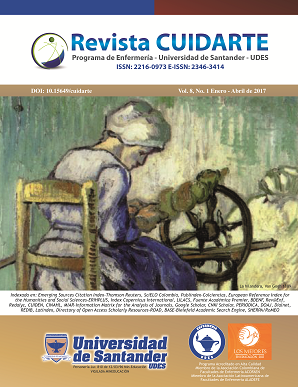Application of Mendelian randomization: can we establish causal risk factors for type 2 diabetes in low-to-middle income countries?
DOI:
https://doi.org/10.15649/cuidarte.v8i1.373Palabras clave:
diabetesResumen
The global burden of type 2 diabetes (T2D) is increasing, partially facilitated by a sharp increase in the disease in low and middle income countries (LMICs). LMICs not only show a high prevalence of T2D (8.7%), but have shown a much faster increase in this prevalence over the past 30 years when compared to high-income countries (HICs). Conventional risk factors for T2D in HICs, such as high body mass index (BMI), low levels of physical activity, and poor dietary behaviours, do not fully account for the greater increase in prevalence of T2D in LMICs. Therefore, risk factors for T2D specifically within an LMIC context need to be determined.
How to cite this article: Langdon RJQ, Wade KH. Application of Mendelian randomization: can we establish causal risk factors for type 2 diabetes in low-to-middle income countries? Rev Cuid. 2017; 8(1): 1391-406. http://dx.doi.org/10.15649/cuidarte.v8i1.373
Referencias
NCD Risk Factor Collaboration (NCD-RisC). Worldwide trends in diabetes since 1980: a pooled analysis of 751 population-based studies with 4.4 million participants. Lancet. 2016; 387 (10027): 1513-30. http://dx.doi.org/10.1016/S0140-6736(16)00618-8
Dagenais GR, Gerstein HC, Zhang X, McQueen M, Lear S, Lopez-Jaramillo P, et al. Variations in Diabetes Prevalence in Low-, Middle-, and High-Income Countries: Results From the Prospective Urban and Rural Epidemiological Study. Diabetes Care. 2016; 39(5):780-7. http://dx.doi.org/10.2337/dc15-2338
Prospective Studies Collaboration, Whitlock G, Lewington S, Sherliker P, Clarke R, Emberson J, Halsey J, et al. Body-mass index and cause-specific mortality in 900000 adults: collaborative analyses of 57 prospective studies. Lancet. 2009; 373(9669):1083-96. http://dx.doi.org/10.1016/S0140-6736(09)60318-4
Zaccardi F, O'Donovan G, Webb DR, Yates T, Kurl S, Khunti K, et al. Cardiorespiratory fitness and risk of type 2 diabetes mellitus: A 23-year cohort study and a meta-analysis of prospective studies. Atherosclerosis. 2015; 243(1):131-7. http://doi.org/10.1016/j.atherosclerosis.2015.09.016
Ezzati M, Riboli E. Behavioral and dietary risk factors for noncommunicable diseases. N Engl J Med. 2013; 369(10):954-64. https://doi.org/10.1056/NEJMra1203528
Haycock PC, Burgess S, Wade KH, Bowden J, Relton C, Davey Smith G. Best (but oft-forgotten) practices: the design, analysis, and interpretation of Mendelian randomization studies. Am J Clin Nutr. 2016; 103(4): 965-78. https://doi.org/10.3945/ajcn.115.118216
Davey Smith G, Hemani G. Mendelian randomization: genetic anchors for causal inference in epidemiological studies. Hum Mol Genet. 2014; 15; 23(R1): R89-98. https://doi.org/10.1093/hmg/ddu328
Sandhu MS, Debenham SL, Barroso I, Loos RJ. Mendelian randomisation studies of type 2 diabetes: future prospects. Diabetologia. 2008; 51(2):211-3. https://doi.org/10.1007/s00125-007-0903-x
Swerdlow DI. Mendelian Randomization and Type 2 Diabetes. Cardiovasc Drugs Ther. 2016; 30(1):51-7. https://doi.org/10.1007/s10557-016-6638-5
Corbin LJ, Richmond RC, Wade KH, Burgess S, Bowden J, Davey Smith G, et al. BMI as a modifiable risk factor for type 2 diabetes: refining and understanding causal estimates using Mendelian randomisation. Diabetes. 2016; 65(10): 3002-7. https://doi.org/10.2337/db16-0418
Borges MC, Hartwig FP, Oliveira IO, Horta BL. Is there a causal role for homocysteine concentration in blood pressure? A Mendelian randomization study. Am J Clin Nutr. 2016;103(1):39-49. https://doi.org/10.3945/ajcn.115.116038
van Meurs JB, Pare G, Schwartz SM, Hazra A, Tanaka T, Vermeulen SH, et al. Common genetic loci influencing plasma homocysteine concentrations and their effect on risk of coronary artery disease. Am J Clin Nutr. 2013; 98(3):668-76. https://doi.org/10.3945/ajcn.112.044545
The International Consortium for Blood Pressure Genome-Wide Association Studies. Genetic variants in novel pathways influence blood pressure and cardiovascular disease risk. Nature. 2011; 478(7367):103-9. https://doi.org/10.1038/nature10405
Hartwig FP, Horta BL, Davey Smith G, de Mola CL, Victora CG. Association of lactase persistence genotype with milk consumption, obesity and blood pressure: a Mendelian randomization study in the 1982 Pelotas (Brazil) Birth Cohort, with a systematic review and meta-analysis. Int J Epidemiol. 2016; 45(5): 1573- 87. https://doi.org/10.1093/ije/dyw074
Ehret GB, Ferreira T, Chasman DI, Jackson AU, Schmidt EM, Johnson T, et al. The genetics of blood pressure regulation and its target organs from association studies in 342,415 individuals. Nat Genet. 2016;48(10):1171-84. https://doi.org/10.1038/ng.3667
Zanetti D, Weale ME. True causal effect size heterogeneity is required to explain trans-ethnic differences in GWAS signals. bioRxiv. 2016. http://dx.doi.org/10.1101/085092
Descargas
Publicado
Cómo citar
Número
Sección
Categorías
Altmetrics

Descargas
Licencia
Journal Cuidarte, scientific publication of open access, is licensed under a Creative Commons Attribution (CC BY-NC), which permits use, distribution and reproduction in any medium, provided the original work is properly cited and is not used for commercial purposes.
Any other form of use such as reproduction, transformation, public communication or distribution, for profit, requires the prior authorization of the University of Santander UDES.
The names and e-mail addresses entered in the Journal Cuidarte will be used exclusively for the purposes stated by this magazine and will not be available for any other purpose or other person.
The articles published in the Journal Cuidarte represent the criteria of their authors and do not necessarily constitute the official opinion of the University of Santander UDES.








